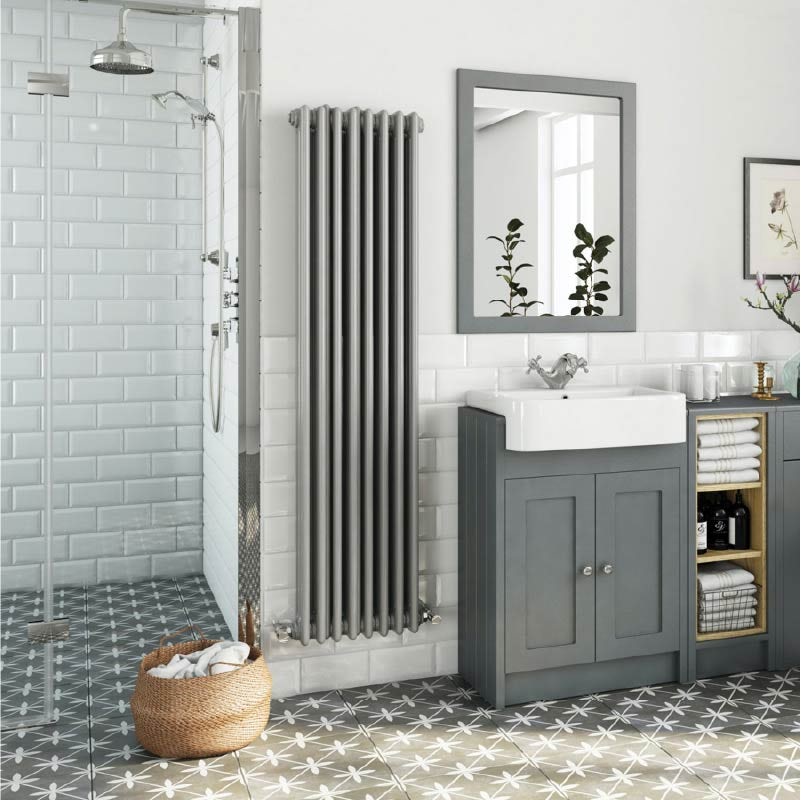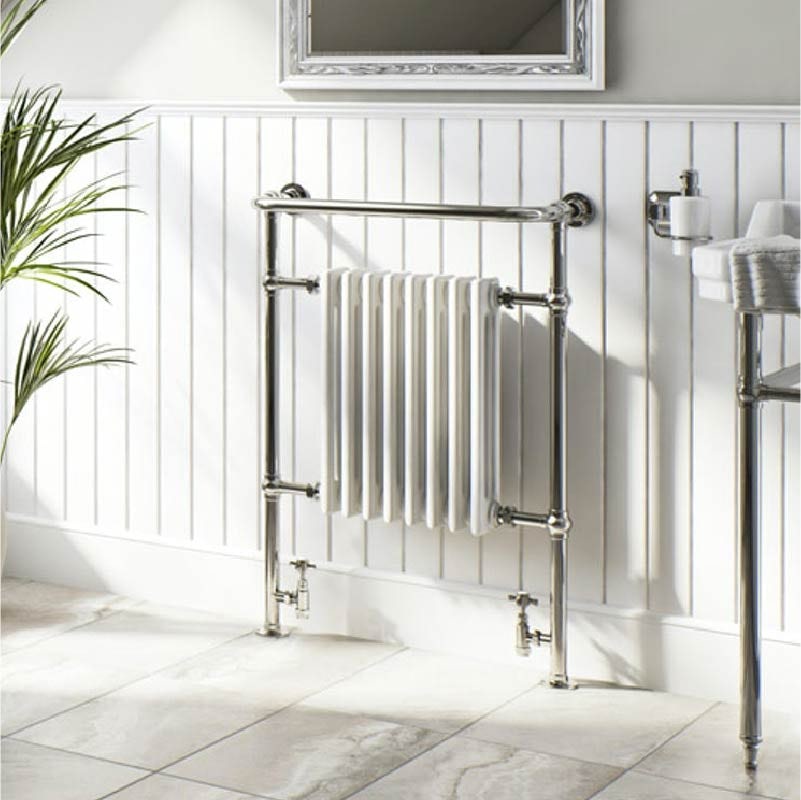Getting that authentic vintage look with the perfect traditional radiator? Find out everything you need to know with our expert guide.
Today’s traditional radiators are reminiscent of designs made during the Victorian and Edwardian eras, although far more accessible and affordable than they were to the vast majority of people back then. The vintage, almost industrial style, appearance fits perfectly into modern homes with contemporary or traditional interiors and they look wonderful in rooms of all sizes.
In this article we explain more about traditional radiators—how they are mounted, colour options, accessories and more, giving you all the information you need to buy the perfect model for your home.
What is a traditional radiator?
A traditional radiator is a classically designed radiator that recalls those manufactured during Victorian and Edwardian periods. This is when radiators slowly started to appear in an increasing number of homes (although they didn’t become commonplace until the mid-20th century). Radiators are now installed as standard in all properties and have since been modernised, but traditional style radiators from the Victorian period remain popular today. A traditional radiator is made up of 2 main components:
Columns
These are the vertical tubes that run from the top and bottom of each section of the radiator. In most cases you will find traditional radiators that features 2-4 columns, which dictates the overall size and scale. Larger sizes can be also purchased, although these tend to be for sizeable rooms and spaces.
Sections
This will determine the overall length of the radiator with a minimum of 3 sections usually required in order to produce the required heat. Specialist radiator makers have been known to build radiators with a large amount sections that can extend up to 2 metres in length.
The Corso traditional radiator from The Heating Co. features a double row of columns and is also available in triple or quadruple variants, plus a variety of different widths, depending on the heat output you need
Mounting options
Traditional radiators are usually mounted in one of 3 ways:
Wall mounted
The most common method of mounting a traditional radiator is on the wall, using brackets. The bracket will have clamps that fit onto the back tube, which can then be attached to the wall fixing. This generally applies to European manufactured radiators, although it can differ to those made in other parts of the world, which may require a hook bracket that doesn’t look as discreet.
Supported
Traditional radiators with support feet offer a classic vintage style similar to those made and used during the 19th century made from cast iron. These tend to be used for large or heavy radiators, where the wall may not be strong enough to support them.
Freestanding feet
Radiators with slip-on feet has become the norm after this style previously used welded sections. The feet are secured to the floor using bolts or screws to ensure their stability.
Finish and colour options
Traditional radiators are commonly made from steel and feature a powder coat treatment, as this kind of paint is particularly resistant to corrosion, ensures high levels of heat resistance and maintains the colour tone.
In the vast majority of cases, you’ll find that as with modern radiators, traditional variants are usually sold in white so they can adapt to a range of interior designs. However, grey, anthracite and black colours are becoming increasingly popular choices, with gloss, satin and sometimes textured surfaces also available.
The advantage of manufacturing radiators with steel is that they can easily be painted by homeowners. This involves applying a specialist radiator or metal primer to the surface before using a good quality emulsion paint and clear radiator overcoat to ensure a good finish.
To complement your chosen colour scheme, you may prefer a satin grey traditional radiator to the more common white
Choosing the right radiator size
The two main things to consider when purchasing a radiator is the size and heat output (measured in BTU (British Thermal Unit)). First of all you need to know the space available in the room so you can determine the maximum length of the radiator.
Some rooms require more than one radiator because a single installation is not enough to heat the space, or the wall does not allow room enough for a radiator that can provide sufficient heat. Aesthetically, having two radiators in the room can also ensure better distribution of heat and look more pleasing to the eye. Traditional radiators are usually wide in length, although in recent times, due to the increased installation of bi-fold doors, vertical designs are also becoming more commonplace.
To find out the correct BTU you can use our BTU calculator which will help you understand the output level required.
Traditional radiator accessories
Some traditional radiators require additional accessories such as valves in order to be fully operational, or you may just want to add the finishing touch to create an authentic look.
Mounting feet
As we mentioned earlier in the article, mounting feet are used with either free-standing radiators or to support heavy-duty radiators that may place too much of a strain onto the wall. These tend to come in plain white colours and like radiators can be painted to match the desired colour.
Radiator valves
As some traditional radiators do not come with valves included you may need to buy these additionally. You’ll find modern-looking steel valves or more traditional-style options—it comes down to the style you want to create in the room.
You’ll also need to choose between manual and TRV (controlled by thermostat) valves. TRV valves are generally viewed as being more energy-efficient and produce a more even distribution of heat. Finally, you’ll also need to be aware of the direction of your pipes so you can choose between straight, angled or corner designs. A general overview of this element is:
- Straight: For pipes that run along the wall—which is the case in many homes
- Angled: Purchase these if pipes come up through the floor into the bottom of the valves
- Corner: Ideal for pipes that come out from the wall into the rear of the valves
Sleeve kits
Sleeve kits are also referred to as pipe shrouds. These metal tubes can be purchased to fit over the inlet pipes to create a better looking finish between the valve and floor beneath. Depending on the type of valve you buy the sleeve will be provided with a matching finish. They also come with matching floor plates that will ensure the sleeves remain firmly in place and covers up any areas where the pipe connected to the wall or floor can be seen.
A set of traditional valves really enhances the look of the Santa Fe traditional radiator from The Heating Co.
Benefits of traditional radiators
If you are still unsure about purchasing a traditional radiator, take the following into consideration when making your decision:
High heat output
When compared to other styles of radiators of a similar size, traditional radiators produce a higher output of heat on a consistent basis. This is due to the large surface area that enables them to maintain a steady flow of heat, which is even true for models with a smaller number of columns.
Rooms with high ceilings
Due to the higher levels of heat output traditional radiators are ideal for rooms with tall walls and high ceilings. Heat always rises naturally and rooms with more height benefit from heating systems that have a superior heat output that can warm the space effectively.
Size flexibility
Traditional radiators are broken down into columns, which means there is a wide variety of sizes available to suit both wall and room sizes. A 2 column radiator is the smallest size available and there are no limitations on the number of columns allowed for larger sizes.
Different designs
Not only are there a range of size options for traditional radiators, but that is also true for horizontal and vertical designs. As we mentioned earlier, tall, vertical designs work well in conjunction with bi-fold doors, or if you have plenty of room you can go for large, bulkier horizontal units that suit the architecture of the space.
Additional features
While traditional radiators are vintage in style, it doesn’t mean they can’t be upgraded to operate in a modern way. If you purchase a model with traditional valves these can be changed at any time to TRV (thermostatically controlled) valves, giving you greater control over heat output to manage heat levels and energy consumption.
Traditional radiators at Victoria Plum
If you’ve been convinced that vintage style is the right choice for you, why not browse our wide range of traditional radiators? Simply click on the image below to begin browsing.














